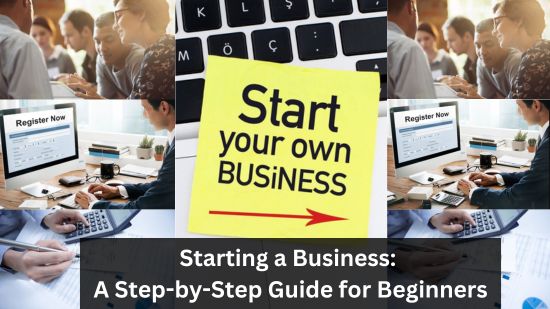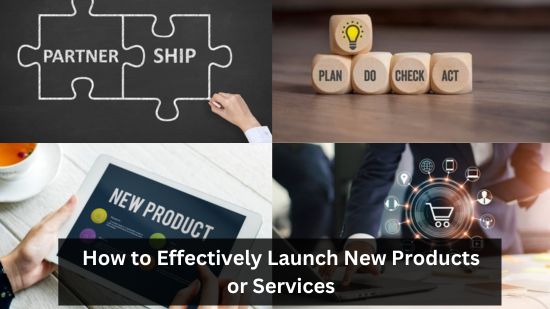
Starting a Business: A Step-by-Step Guide for Beginners
“Starting a Business: A Step-by-Step Guide for Beginners”
Starting a business can be both an exciting and daunting experience. With the proper knowledge and a clear plan, you can navigate the complexities and set your business up for success. This guide provides a step-by-step approach to help beginners understand the essential components of starting a business, from the initial idea to sustainable growth.
Understanding Business Basics
Importance of Market Research
Market research is a critical first step in starting a business. It involves gathering information about your target market, understanding customer needs, and analyzing competitors. Conducting thorough market research helps you make informed decisions, identify opportunities, and minimize risks. It provides insights into market trends, consumer behavior, and potential challenges, enabling you to tailor your business strategy accordingly.
Defining Your Business Idea
A clear and unique business idea is the foundation of any successful venture. Start by identifying a problem or need in the market that your business can address. Consider your skills, passions, and experiences to develop a concept that resonates with you and your potential customers. A well-defined business idea should be specific, feasible, and scalable, laying the groundwork for your business plan and future operations.

Credit: carvedculture.com
Creating a Business Plan
Components of a Business Plan
A comprehensive business plan outlines your business goals, strategies, and financial projections. Key components include:
- Executive Summary: A brief overview of your business and its objectives.
- Business Description: Detailed information about your business, including its mission, vision, and values.
- Market Analysis: Insights from your market research, including target market, industry trends, and competitive analysis.
- Marketing and Sales Strategy: Plans for attracting and retaining customers.
- Organizational Structure: Details about your team and management roles.
- Product or Service Line: Description of your products or services and their benefits.
- Financial Projections: Revenue forecasts, funding requirements, and financial statements.
Setting Realistic Goals
Setting realistic and achievable goals is crucial for measuring your business’s progress. Establish short-term and long-term objectives that align with your business vision. Define your goals using the SMART criteria (Specific, Measurable, Achievable, Relevant, Time-bound). Review and adjust them regularly based on your business performance and market conditions.
Choosing the Right Business Structure
Types of Business Structures
Choosing the proper business structure affects your legal responsibilities, taxes, and personal liability. Common types include:
- Sole Proprietorship: A single-owner business with complete control but also entire personal liability.
- Partnership: A business owned by two or more people sharing profits, losses, and liabilities.
- Limited Liability Company (LLC): This type of company combines the benefits of a corporation and a partnership, offering limited liability and flexibility.
- Corporation: A separate legal entity owned by shareholders, providing limited liability but with more regulatory requirements.
- S Corporation: A particular type of corporation with pass-through taxation benefits.
Benefits and Drawbacks of Each Structure
Each business structure has its pros and cons. Sole proprietorships and partnerships are more accessible to set up and offer direct control but come with personal liability risks. LLCs provide limited liability protection and tax flexibility, while corporations offer strong liability protection and easier access to capital but face more regulatory requirements and double taxation. S Corporations avoid double taxation but have eligibility restrictions. Choose a structure that best aligns with your business goals, financial situation, and risk tolerance.

Credit: expertpoint.in
Registering Your Business
Legal Requirements and Regulations
Registering your business involves complying with various legal requirements and regulations. Start by choosing a business name and ensuring it’s not already in use. Register your business with the appropriate government authorities, which may include obtaining a business license, registering for taxes, and applying for any necessary permits. Understanding and adhering to local, state, and federal regulations is essential to avoid legal issues and ensure your business operates smoothly.
Obtaining Necessary Permits and Licenses
Different industries and locations require specific permits and licenses to operate legally. Research the requirements for your business type and location. Common permits include health and safety permits, environmental permits, and professional licenses. Applying for and securing the necessary permits and licenses early in the process prevents delays and ensures compliance with regulatory standards.
Securing Financing for Your Business
Understanding Different Financing Options
Financing is crucial for starting and growing your business. Common financing options include:
- Personal Savings: Using your own money to fund your business.
- Bank Loans: Borrowing money from a bank with the obligation to repay with interest.
- Angel Investors: Individuals who invest their own money in exchange for equity.
- Venture Capital: Investment from firms that specialize in funding startups in exchange for equity.
- Crowdfunding: Raising small amounts of money from a large number of people, typically via online platforms.
Tips for Successful Business Financing
Securing financing requires careful planning and a compelling pitch. Prepare a detailed business plan and financial projections to present to potential investors or lenders. Highlight your business’s unique value proposition, market potential, and growth strategy. Build a strong credit history and maintain good relationships with financial institutions. Explore multiple financing options to find the best fit for your needs and circumstances.
Setting Up Your Business Location
Choosing Between Physical and Online Presence
Deciding whether to operate your business from a physical location, online, or a combination of both depends on your business model and target market. A physical location may be necessary for retail stores, restaurants, or service-based businesses, while an online presence suits E-commerce and digital services. Consider factors such as customer convenience, costs, and scalability when making your decision.
Selecting the Ideal Location
If you choose a physical location, selecting the right site is crucial for your business’s success. Consider factors like foot traffic, accessibility, competition, and costs. Evaluate different areas and properties to find a location that meets your operational needs and budget. Negotiate lease terms and ensure the space aligns with your business requirements and future growth plans.

Credit: moneymarshmallow.com
Building Your Brand
Developing a Unique Brand Identity
Your brand identity sets you apart from competitors and creates a memorable impression on customers. Develop a unique brand name, logo, and tagline that reflect your business values and mission. Consistent branding across all marketing materials and customer interactions builds recognition and trust. Define your brand’s voice and tone to ensure cohesive and effective communication.
Importance of Branding in Business Success
Strong branding enhances customer loyalty and drives business growth. It helps you establish a distinct presence in the market, attract your target audience, and differentiate yourself from competitors. Invest in professional branding and maintain consistency across all touchpoints, including your website, social media, packaging, and advertising. A well-defined brand builds credibility, fosters customer trust, and contributes to long-term success.
Creating an Online Presence
Building a Professional Website
A professional website is essential for establishing your online presence. It serves as a digital storefront, providing information about your products or services, contact details, and customer testimonials. Ensure your website is user-friendly, mobile-responsive, and optimized for search engines. Incorporate high-quality content, clear calls-to-action, and secure payment options to enhance user experience and drive conversions.
Utilizing Social Media for Business Growth
Social media platforms offer powerful tools for marketing and customer engagement. Create profiles on relevant platforms like Facebook, Instagram, Twitter, and LinkedIn to reach your target audience. Share engaging content, interact with followers, and run targeted ad campaigns to increase brand visibility and drive traffic to your website. Monitor your social media performance and adjust your strategy based on insights and feedback.
Marketing and Sales Strategies
Effective Marketing Techniques
Effective marketing is crucial for attracting and retaining customers. Combine traditional marketing methods like print advertising, direct mail, and events with digital marketing strategies such as content marketing, email marketing, and search engine optimization (SEO). Identify the channels that best reach your target audience and allocate your marketing budget accordingly. Track your marketing efforts and measure their effectiveness to optimize your campaigns.
Building a Strong Sales Strategy
A strong sales strategy drives revenue and business growth. Develop a sales plan that outlines your target market, sales goals, and tactics for acquiring and retaining customers. Train your sales team to understand your products or services and effectively communicate their value to prospects. Implement a customer relationship management (CRM) system to manage leads, track sales activities, and analyze performance. Continuously refine your sales process to improve conversion rates and customer satisfaction.
Hiring and Managing Employees
Recruitment Strategies for Startups
Hiring the right employees is crucial for your business’s success. Develop a clear job description and use multiple channels to attract candidates, including job boards, social media, and networking events. Evaluate candidates based on their skills, experience, and cultural fit. Consider hiring freelancers or part-time employees to manage costs and flexibility. Provide a positive candidate experience and streamline your hiring process to attract top talent.
Effective Employee Management Practices
Effective management practices foster a productive and motivated workforce. Communicate your business goals and expectations clearly to your employees. Provide regular feedback and recognize their achievements. Invest in employee development through training and career advancement opportunities. Foster a positive work culture that promotes collaboration, innovation, and work-life balance. Address any issues promptly and maintain open communication to build a loyal and engaged team.

Credit: stridepost.com
Understanding Taxes and Accounting
Basic Accounting Principles
Understanding basic accounting principles is essential for managing your business finances. Keep accurate records of your income, expenses, and financial transactions. Use accounting software to streamline bookkeeping and generate financial reports. Understand critical financial statements like the balance sheet, income statement, and cash flow statement. Regularly review your financial performance to make informed decisions and ensure your business’s economic health.
Navigating Business Taxes
Complying with tax regulations is crucial to avoid legal issues and penalties. Determine the taxes your business is required to pay, such as income tax, sales tax, and payroll tax. Keep detailed records of your transactions and expenses to support your tax filings. Consider hiring a tax professional or accountant to ensure accurate and timely tax reporting. Stay updated on tax laws and regulations to maintain compliance and take advantage of any available tax benefits.
Ensuring Legal Compliance
Adhering to Employment Laws
Compliance with employment laws is essential for managing your workforce and avoiding legal issues. Understand and adhere to regulations regarding wages, working hours, and employee benefits. Implement policies for workplace safety, discrimination, and harassment prevention. Maintain accurate records of employee information and ensure proper documentation of hiring, termination, and disciplinary actions. Regularly review and update your policies to stay compliant with changing laws.
Understanding Intellectual Property Rights
Protecting your intellectual property (IP) is crucial for safeguarding your business assets. Understand the different types of IP, including trademarks, copyrights, and patents. Register your business name, logo, and any unique products or services to prevent unauthorized use. Monitor and enforce your IP rights to maintain your competitive advantage. Consider consulting with an IP attorney to navigate the complexities of IP protection and ensure your business is adequately protected.
Scaling Your Business
Strategies for Business Growth
Scaling your business requires careful planning and execution. Identify opportunities for growth, such as expanding your product line, entering new markets, or increasing your customer base. Develop a growth strategy that outlines your goals, resources, and timeline. Invest in technology and infrastructure to support scalability. Build a strong team and delegate responsibilities to manage the increased workload. Monitor your progress and adjust your strategy based on market conditions and business performance.
Managing Business Expansion
Managing business expansion involves balancing growth with operational efficiency. Develop a detailed expansion plan that includes market research, financial projections, and risk analysis. Secure the necessary funding and resources to support your expansion. Implement systems and processes to maintain quality and consistency as you grow. Monitor key performance indicators (KPIs) to measure your progress and make data-driven decisions. Stay agile and adapt to changes to ensure successful expansion.

Credit: thebalance.com
Handling Business Challenges
Common Challenges Faced by Startups
Startups often need help with various challenges, including limited resources, competition, and market volatility. Common issues include cash flow management, customer acquisition, and scaling operations. Staying informed and proactive helps mitigate these challenges. Develop contingency plans and seek advice from mentors or industry experts. Embrace a growth mindset and view challenges as opportunities for learning and improvement.
Tips for Overcoming Business Obstacles
Overcoming business obstacles requires resilience and strategic thinking. Break down complex problems into manageable tasks and prioritize them based on urgency and impact. Seek feedback from customers, employees, and stakeholders to gain different perspectives. Stay focused on your long-term vision and adapt your strategies as needed. Leverage technology and innovation to streamline operations and improve efficiency. Celebrate small wins and maintain a positive outlook to keep yourself and your team motivated.
Maintaining Business Sustainability
Importance of Sustainable Practices
Sustainability is becoming increasingly important in the business world. Adopting sustainable practices benefits the environment and enhances brand reputation and customer loyalty. Implement eco-friendly policies such as reducing waste, conserving energy, and sourcing sustainable materials. Engage with your community and customers to promote sustainability initiatives. Track your sustainability efforts and report your progress to stakeholders.
Long-Term Planning for Business Success
Long-term planning is essential for ensuring your business’s continued success. Develop a strategic plan that outlines your vision, goals, and action steps for the future. Regularly review and update your plan to reflect changes in the market and business environment. Invest in innovation and continuous improvement to stay competitive. Foster a culture of adaptability and resilience within your organization to navigate challenges and seize opportunities.

Credit: johnacademy.co.uk
FAQs
What is the first step to starting a business?
The first step is conducting market research to understand your target market and identify opportunities.
How do I choose the proper business structure?
Consider factors like liability, taxes, and regulatory requirements. Consult with a legal or financial advisor for guidance.
What are the key components of a business plan?
Key components include an executive summary, business description, market analysis, marketing strategy, organizational structure, and financial projections.
How can I secure financing for my business?
Explore options like personal savings, bank loans, angel investors, venture capital, and crowdfunding. Prepare a strong business plan to present to potential investors.
What legal requirements must I comply with when starting a business?
Register your business name, obtain necessary permits and licenses, and adhere to local, state, and federal regulations.
How important is branding for my business?
Branding is crucial for creating a memorable impression, building customer loyalty, and differentiating your business from competitors.
Conclusion
Starting a business is a complex but rewarding journey. By following this step-by-step guide, beginners can navigate the challenges and set their businesses up for success. From understanding the basics to scaling operations, each stage requires careful planning and execution. Stay informed, adaptable, and committed to your vision to build a thriving business. Remember, the key to long-term success lies in continuous learning, innovation, and maintaining a positive mindset.






